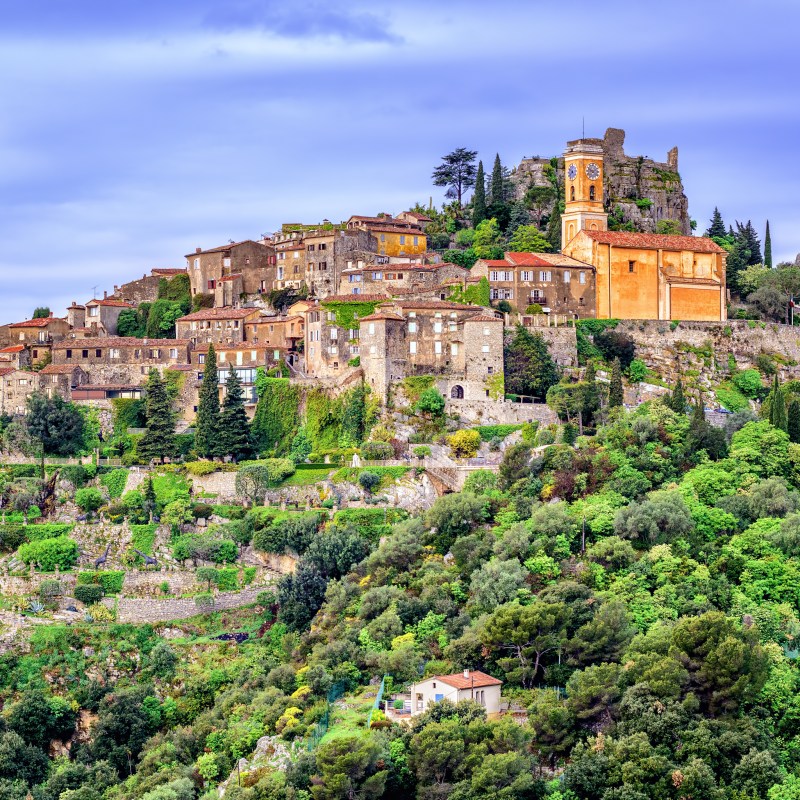
Nice is the largest city on the Cote d’Azur, or the French Riviera, the international playground bordering the Mediterranean Sea. Rich in history and culture, Nice is a great place to spend a few days. However, Nice is also a perfect base for exploring many of the surrounding towns and villages. Below is a list of choice places and attractions that are less than an hour away and make memorable day trips.
Videos by TravelAwaits
Almost all of these destinations are accessible by train, and the train system along the Cote d’Azur is highly efficient (trains run approximately twice an hour), inexpensive, and user friendly. You can purchase a day or week pass online.

1. Antibes
Leaving Paris in 1946 because of an invitation from a friend to come to the south of France led Picasso to live in the old village of Antibes for three months. A former fort from the 14th century had been transformed into a city-run history museum, and the vast space was almost half empty. Picasso set up his atelier in a guard’s passage, and there, he produced 23 paintings and 44 drawings in a period of two months, then donated them to the museum as a gift.
Today, it is the Picasso Museum, and it displays Picasso’s collection in its own gallery. The museum has an outdoor sculpture garden that hangs over the Mediterranean, providing scenic views. The museum also hosts exhibits by other artists.
Antibes has an impressive harbor lined with superyachts and boats, and the charming old town has small-scale buildings painted in shades of marigold, aqua blue, and rose pink.

2. Beaulieu-Sur-Mer And Villa Kerylos
The highlight of the sleepy, seaside town of Beaulieu-sur-Mer, just 15 minutes from Nice, is the magnificent Villa Kerylos. Conceived by archaeologist Theodore Reinach, who married Fanny Kann, a wealthy heiress from the Ephrussi banking fortune, the house was built to resemble an ancient Greek villa. Construction started in 1902 and took six years to build with no expense spared. Exact copies of Grecian chairs and other furniture from the collection of originals from the National Archaeological Museum in Naples were made exclusively for the home. Villa Kerylos featured the latest in the modern technology of the time, including indoor plumbing and heated floors.
It takes a good hour to soak up all the architectural details, such as the intricate mosaic floors, the Greek columns lining the courtyard, the extravagant bathrooms, and the handsome wood furniture. Make sure to visit the terrace overlooking the sea and the garden filled with olive, pomegranate, and cypress trees.

3. Saint Paul De Vence
Although technically not on the Cote d’Azur, Saint Paul de Vence is a must on this list. Located in the mountains about 30 minutes from Nice, it is accessible by car or public bus. A hilly and medieval town, Saint Paul de Vence is a mini art haven with many galleries and a major art foundation.
In 1964, art collectors Aime and Marguerite Maeght envisioned a space where they could invite their artist friends to work and display their work. They entrusted their vision to Catalan architect Josep Lluis Sert, who designed the studio for artist Joan Miro. Today, the Maeght Foundation is dedicated to showing the best contemporary artists and has one of the largest and most significant collections of 20th-century art in Europe, with works by Chagall, Ellsworth Kelly, Fernand Leger, Pierre Bonnard, Sam Francis, and Braque. At the entrance to the foundation is a sculpture park with whimsical works by Giacometti, Calder, and Joan Miro. They also have temporary exhibitions featuring current-day artists.
After your visit to the Maeght Foundation, treat yourself to lunch at the legendary La Colombe d’Or Hotel and restaurant. The small hotel with only twelve rooms was opened in 1931 as a place where the owner could house working artists. Over the years, it became a magnet not only for artists but for the rich and famous, including Yves Montand and Simone Signoret. The walls of the hotel and restaurant are filled with paintings by Picasso, Matisse, Yves Klein, Cesar, and Buffet.

4. Saint-Jean-Cap-Ferrat And Villa Ephrussi
A vision in pink stone awaits you on a hill in Saint-Jean-Cap-Ferrat, a resort town known for its wealthy and aristocratic residents. The magnificent Villa Ephrussi estate was built for Beatrice de Rothschild, of the French banking family, who was married to Baron Maurice de Ephrussi. When the baroness died in 1934, she bequeathed the estate to Beaux-Arts Academy, who in turn opened it to the public.
Designed by one of the leading architects of the time, Aaron Messiah, the exterior made reference to an Italian palazzo and to the Italian Renaissance period. The interior is decorated with sumptuous antiques, paintings by Old Masters, and Carrara marble, and a single room is dedicated to porcelain from the Sevres, the royal porcelain maker of France. One wing of the mansion has a series of rooms that comprised the private apartment of Beatrice de Rothschild. You can view her boudoir swathed in Chinese embroidered silk, the dressing room, and the extravagant bathroom with wood panels hand painted by artist Pierre Leriche, who was a painter for Marie Antoinette.
Perhaps even more spectacular than the mansion is the series of nine gardens in various styles, including Spanish, Italian, French, Japanese, Provencal, exotic, stone, and rose. A cypress-covered hill has a replica of the Temple of Love garden in the Petit Trianon, the home of Marie Antoinette at Versailles.
The villa hosts two annual events, Painters Day, during which artists are invited to paint in the gardens for inspiration, and an opera festival featuring young and upcoming musicians and singers.

5. Villefranche
Just next door to Nice is the tiny village of Villefranche. While climbing the vertically designed village, you will discover its hidden charms, including as the hanging gardens and peekaboo views of the sea at its bluest.
Artist Jean Cocteau, frequented Villefranche, where he made friends with the local fisherman and hand painted the facade and inside of the Saint Pierre chapel.
Walk through the Rue Obscure, aptly named for a dark passageway that dates back to 1260.
Have lunch at one of the many seafood restaurants with outdoor terraces lining the beach.
One of the top French language schools in France, Institut de France, offers two- and four-week-long immersion classes in French. The intensive classes are given five days a week and include two meal breaks during which speaking French is mandatory.

6. Eze Village
The astounding view 1,400 feet above the Mediterranean sea, is reason enough to visit Eze Village. A longtime favorite place on the Cote d’Azur, Eze is the highest seaside village in all of France.
It is a challenging climb to the top of the village, but you will be justly rewarded along the way. You will discover medieval stone houses with window boxes overflowing with seasonal flowers, shady squares to rest at, and cute boutiques, arts and crafts galleries, and local souvenir shops.
Another reward that awaits you in Eze is the Exotic Botanical Garden, covered with variations of cactus plants, agave plants, and other succulents.
Galimard is a historical French perfume line started in 1747, and the brand has a perfume museum at the base of Eze. During the 45-minute tour, given in English, a guide will introduce you the intricate process of perfume making, from the first step of extracting liquid from the flowers to the final step of bottling the essence. Galimard also makes soap, and the tour includes an introduction to the soap making process. There’s a boutique that stocks Galimard perfumes, soaps, and gift packages.
Another well-known perfume and soap company, Fragonard, which is named after the local-born artist, has a laboratory in Eze. Inside an old house, you can learn the ins and outs of how Fragonard’s products — including their cosmetics and facial creams — are made. At the end of the tour, you will have the opportunity to shop their perfumes, soaps, candles, and shower gels.

7. Grasse
Grasse is the home of the stupendous lavender fields that are pictured in almost all articles about the south of France. The glorious-smelling and looking purple stalks are used as a prime ingredient in perfume. Prime time to see the lavender fields is from mid-June to the beginning of August. Grasse is also the capital of the luxury perfume industry in France, and many of the top brands have their headquarters in Grasse.
The International Perfume Museum, opened in 1989, covers all aspects of the art of perfume making including its ancient history, its psychological effects, its allure, manufacturing, and innovation, and the design of the packaging and bottles. Tracing the history of perfume chronologically, the museum is divided into the following sections: Antiquity, Middle Ages, Modern, and Contemporary.
If you missed the Galimard and Fragonard perfume museums in Eze, both also have branches in Grasse.
Pro Tip
Since the Cote d’Azur has a sunny climate most of the year, a high SPF sunblock is a must. Many of the villages listed in the article have cobblestone pathways, so make sure to wear sneakers or thick, rubber-soled walking shoes. Also, don’t miss the best things to see and do in Nice before or after experiencing these charming towns.
